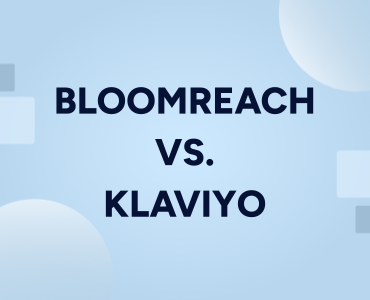Fierce fashion, fierce fashion marketing competition
In this digital age, it is vital to consider the look and feel of your website and app, and how well you can execute 1:1 personalization tailored to each individual shopper.
The competition for profits in the fashion industry is dominated by only 20 companies, and of this group, 12 have been members for the past decade. These companies may be dominant, but are less likely to deviate from the longstanding model of success, therefore, being a disrupter and challenging established rules is a winning strategy for the remaining players in the game.
Although top fashion enterprises may get away with mediocre eCommerce websites and generic customer experiences for the time being, this won’t serve them in the long run.
Industry norms are changing. More than ever, consumers crave individualized digital experiences. Businesses have no choice but to adapt to the rapidly changing preferences of their consumers. We’ve put together this eBook to give you an in-depth overview of the challenges marketers in the fashion industry are facing today.
Top challenges for marketers in the fashion world
Eliminating the need for customers to touch, feel, or try out products before buying
As more and more people are taking their shopping experiences online, purchases via mobile devices are at an all-time high. An estimated 77% of consumers in the US use mobile devices when shopping, especially when comparing prices between eCommerce sites. Therefore, creating a convenient and seamless shopping experience is crucial to increase conversions, drive revenue, and inspire lasting customer loyalty.
Improving product discovery by getting personalization right
Gone are the days when churning out generic content was enough to keep customers engaged. Personalized experiences are at the forefront of modern shopping. According to McKinsey, 71% of consumers expect personalized interactions from companies.
Not only is generic content not oriented to your specific audience, it also fails to demonstrate value to the customer, a crucial factor in driving sales and boosting loyalty. When it comes to showing customers what makes your product different from the competition, generic content won’t help. If your products blend in with the rest, your business will suffer.
Understanding how differences in age, gender, and lifestyle impact customer behavior is an absolute must for developing content tailored to each customer. This can be achieved by:
- Cross-channel marketing enriched with smart recommendations
- Using gamification to incentivize purchases
- Streamlining the product discovery process
An example is Insider’s InStory, a fresh way to deploy immersive mobile experiences based on visual storytelling popularized by the social apps your customers love.
Oftent, customers can become overwhelmed by the vast amount of available products and struggle to find exactly what they’re looking for. With content segmentation, visitors receive messages targeted specifically to them. Segmentation ensures that your website’s content is relevant and tailored to buyer persona so you can reduce bounce rate and generate a higher return on sales.
Not letting competition lock you out of the game
Driving loyalty
Earning trust from customers who will keep coming back, resulting in repeat purchases and increasing lifetime value
6 creative strategies for improving the fashion industry’s essential KPIs
- Conversions
- Repeat purchases
- Time spent on site
- Click-through rates
- Cart-to-detail rates
Fashion shoppers by personality type
Everyone has their own unique style and interests when it comes to fashion. However, even among the most diverse group of consumers, there are a few common shopping patterns. We identified six common buying personas based on our own data analysis of consumer behavior.
Let’s meet your shoppers:
Dong-Sun, “The Discount Chaser” — “I always search for the biggest sales and then try to find the best-valued products at a steep discount.”
Horacio, “The High-value Customer” — “I may shop less often, but when I do, I treat myself to the very best products out there. No splurge is too extravagant when I feel like treating myself.”
Bella, “A Brand’s #1 Fan” — “Once I trust a brand, I’ll always keep coming back for more. I’m a brand loyalist through and through.”
Paola, “The Procrastinator” — “I add items to my cart, but don’t check out. I never seem to finish what I start.”
Saachi, “The Size-sensitive Shopper” — “No matter where I look, it’s hard to find items that fit. And to me, the fit is the most important factor I consider when deciding whether or not to buy.”
Keeping these buyer personas in mind is helpful as understanding these types of customer can help you develop your own audience segments and conceptualize segment-specific marketing campaigns and promotions.
Building confidence and engagement in fashion consumers
Traditionally, the offline experience of shopping for clothes, accessories, and bags has been highly sensory, where customers have the opportunity to touch and feel the products in person.
Today, marketers must find new ways to build customer confidence and engagement, such as through customer reviews, which are shown to be highly effective. According to one survey, 88% of online shoppers read a minimum of 3 customer reviews before making a purchase. Another way to create urgency, mass appeal, and FOMO (fear of missing out) is to indicate how many people are currently viewing the given items and how many are left in stock.
Social proof bolsters trust and drives sales
Word-of-mouth is a powerful motivator, so it is vital for businesses to tap into the wisdom of their target audience to build a trusted online presence. Showcasing a given product’s popularity using ratings, number of reviews, and availability of items left in stock will demonstrate trustworthiness to potential customers.
Robust social proof can lead to growth in down-the-funnel conversions, or sales, and are also expected to increase up-the-funnel conversions such as cart-to-detail.
This type of messaging can be used to effectively reach buyer personas like Paola, “The Procrastinator.” Seeing that an item is low in stock and other buyers are considering purchase could motivate Paola to act now, rather than wait for later.
Improving product discovery
KPI: Increasing revenue by speeding up the path to purchase and increasing engagement (time spent, click-through rates).
Complicated shopping experiences are commonplace for mobile customers. It takes the average mobile customer 5 clicks, 3 searches, and 5 filters to find what they’re looking for. On top of that, it can take several visits for a potential customer to successfully complete a purchase. To improve sales, marketers must streamline their online shopping process so shoppers can easily make discoveries and navigate checkout to complete their shopping journey.
Digital-savvy consumers like Amazon Prime customers expect and look for product recommendations. Generic, one-size-fits-all suggestions aren’t going to meet their needs. It’s personalized recommendations that account for differences across age groups, genders, and lifestyles that help drive engagement. Relevant recommendations can lead to increases in metrics including time spent on site, click-through rates, and down-the-funnel conversions, like purchases.
Make it easy for shoppers to find and compare products based on past browsing history
With Insider’s Web Versus solution, a visual browsing history integration, customers can compare products side by side. You can help shoppers who typically require multiple visits to complete a purchase by showing them exactly what they’re looking for in a format that helps them assess product features, prices, and particulars at a glance.
This solution should improve your cart-to-detail rate by increasing the rate of products added per number of product detail views (clicking to see a product detail page or box). For a buyer persona like Dong-Sun, “The Discount Chaser,” this solution helps them easily compare items and see which will deliver the greatest value, increasing likelihood of a sale.
Achieve 1:1 personalized recommendations to boost engagement and conversions
With Insider’s Smart Recommender, a recommendation technology powered by user insights collected across platforms, brands can supercharge discovery and activation by providing relevant product suggestions based on:
- Engagement data and patterns demonstrated by lookalike shoppers
- Past browsing history of returning visitors
- Previous purchases
- Items added to cart activity
To succeed in fashion retail, it’s essential to understand the individual preferences and demographics of fashion shoppers. Marketers can take personalization to the next level by creating micro-segments based on key parameters, such as preferred product price range, and categories of interest. This strategy might be a fit for Bella, “A Brand’s #1 Fan”. As Bella is motivated to buy products from brands she trusts, smart recommendation technology can be leveraged to determine her favorite brands and make suggestions based on these preferences.
Arm fashion shoppers with the info they need
Now that we live in the information age, the internet has armed consumers with all of the intel they need to compare prices and hunt down the very best deal.
McKinsey explains, “with customer traffic on the decline, those in the apparel sector are using promotions to inch forward, but offering deep discounts isn’t sustainable, and it doesn’t have to be the only strategy. There’s another way: to price smarter, using analytics to determine how to set costs by segment and by product type”. According to McKinsey, taking this type of scientific approach to pricing has the power to lift margin and sales by 3-6%.
Make this a callout or button, something that stands out – see the Segment blog for inspiration
Learn more: Optimize fashion eCommerce and conversions with the ultimate guide to creating the perfect product detail page (PDP)
Prioritize offers for high discount affinity fashion consumers
Deliver gamified promotions to user segments who will then be incentivised to purchase. Dong-Sun, “the Discount Chaser” is a buyer persona who is likely to be motivated by the chance of securing a competitive deal. As illustrated by McKinsey’s research “Offering incentives to everyone is a losing strategy for brands trying to win the price wars. When brands evolve beyond this go-to and begin offering highly personalized and engaging experiences, companies can dial back from offering generic, one-size-fits-all incentives and instead focus on prioritizing offers for high discount affinity customers.”
It’s hard enough to convert new customers the first time, but the real task for marketers is to increase repeat sales and subsequent long term ROAS and ROI. Push notifications deployed over the web can be transmitted to both desktop and mobile browsers. These notifications are visible even when customers aren’t actively using your website, giving your brand a method of re-engaging web visitors on an ongoing basis.
Use web push notifications to re-engage fashion customers even when they’re not using your website
While development of web and mobile apps receives a lot of attention from marketers, web push notifications can be used on both desktop and mobile web browsers and should also be considered part of your overall marketing strategy.
As nearly half of all internet time is spent browsing desktop websites, reaching users through this channel can be extremely effective.
Once customers opt into receiving web push notifications from your brand, they can receive these messages whenever they’re browsing online—they can get updates without even visiting your website. When you’re thinking of campaigns to re-engage past customers, consider web push notifications tailored specifically to their previous shopping interests as a way to drive higher revenue.
This type of update could be tailored to Horacio, “The High-value Customer,” by sending a notification emphasizing a product that is one of his favorite high-value items.
For Bella, “A Brand’s #1 Fan,” messaging could be tailored to emphasize her history of loyalty with a brand. An update for Saachi, “The Size-sensitive Shopper,” could emphasize that an item is available in just the right size. And for Paola, “The Procrastinator,” messaging could place a greater emphasis on how items like these sell fast—no time to waste!
Furthermore, with Insider’s dynamic content, powered by real-time consumer intelligence and up-to-date with individual customer characteristics, preferences, and behaviors, you can ensure your web push notifications will always stay fresh.
With the top 20 brands in fashion claiming 97 percent of the profits, the forecast for the fashion industry overall indicates slow growth. Companies are struggling to build engaging and personalized customer experiences, and fashion marketers are facing many key challenges that won’t go away.
 Christopher Lowe
Christopher Lowe
 Christopher Lowe
Christopher Lowe

























